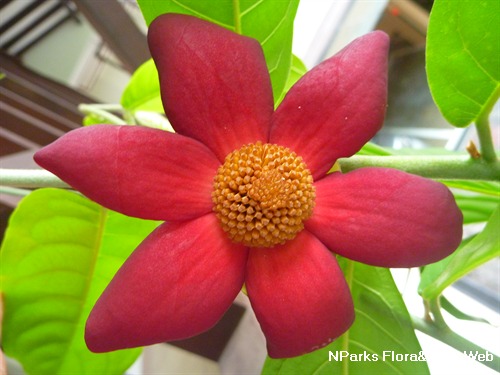
Name
Classifications and Characteristics
| Plant Division | Angiosperms (Flowering Seed Plants) (Dicotyledon) |
|---|---|
| Plant Growth Form | Climber |
| Lifespan (in Singapore) | Perennial |
| Mode of Nutrition | Autotrophic |
| Plant Shape | Irregular |
| Maximum Height | 15 m |
Biogeography
| Native Distribution | Myanmar, Peninsular Malaysia, and Singapore |
|---|---|
| Native Habitat | Terrestrial (Primary Rainforest, Secondary Rainforest) |
| Preferred Climate Zone | Tropical |
| Local Conservation Status | Native to Singapore (Vulnerable (VU)) |
Description and Ethnobotany
| Growth Form | It is a woody and slender climber 5–15 m long. |
|---|---|
| Foliage | Its alternate, stalked leaves have leathery blades that are elliptic-oblong, dark green above, pale bluish-green below, and 10–18 by 6.5–9 cm. Its leaf blade midrib has thin stiff hairs on both sides. Its veins are distinct on both sides. |
| Flowers | Its flowers grow in either singly or pairs at the end axils of the plant, bearing dark red, elliptic petals and are 4.5–5 cm across. |
| Fruit | Its fruits are cylindrical, orange, hairy, and 2–3.5 cm long. Each fruit contains egg-shaped seeds lined in 2 rows. |
| Habitat | It grows in inland forests. |
| Associated Fauna | Its flowers are pollinated by insects. |
| Cultivation | It can be propagated by seed. |
| Etymology | Latin uvaria, clustered fruits, like a bunch of grapes; Latin hirsutus, bristly or hairy, referring to the hairy leaf blades |
Landscaping Features
| Landscaping | It is suitable for parks and gardens, growing on trellises and pergolas. |
|---|---|
| Desirable Plant Features | Ornamental Flowers |
| Landscape Uses | Vertical Greenery / Green Wall, Parks & Gardens, Trellis / Arbour / Pergola |
| Thematic Landscaping | Naturalistic Garden |
Fauna, Pollination and Dispersal
| Pollination Method(s) | Biotic (Fauna) |
|---|---|
| Seed or Spore Dispersal | Biotic (Fauna) |
Plant Care and Propagation
| Light Preference | Full Sun |
|---|---|
| Water Preference | Moderate Water |
| Plant Growth Rate | Moderate |
| Rootzone Tolerance | Fertile Loamy Soils, Well-Drained Soils, Moist Soils |
| Maintenance Requirements | Moderate |
| Propagation Method | Seed |
Foliar
| Foliage Retention | Evergreen |
|---|---|
| Mature Foliage Colour(s) | Green |
| Mature Foliage Texture(s) | Glossy / Shiny, Leathery |
| Foliar Type | Simple / Unifoliate |
| Foliar Arrangement Along Stem | Alternate |
| Foliar Attachment to Stem | Petiolate |
| Foliar Shape(s) | Non-Palm Foliage (Lanceolate, Elliptical, Oblong) |
| Foliar Venation | Pinnate / Net |
| Foliar Margin | Entire |
| Typical Foliar Area | Mesophyll ( 45cm2 - 182.25 cm2 ) |
Non - Foliar and Storage
| Stem Type & Modification | Woody |
|---|---|
| Root Type | Underground (Fibrous Root) |
Floral (Angiosperm)
| Flower & Plant Sexuality | Bisexual Flowers |
| Flower Colour(s) | Red |
|---|---|
| Flower Grouping | Solitary, Cluster / Inflorescence |
| Flower Location | Terminal |
| Flower Symmetry | Radial |
| Flower Lifespan on Plant | Several Days |
| Flowering Habit | Polycarpic |
Fruit, Seed and Spore
| Mature Fruit Colour(s) | Orange |
|---|---|
| Mature Fruit Texture(s) | Hairy / Hirsute |
| Fruit Classification | Aggregate Fruit (Syncarp) |
| Fruit Type |
Image Repository
Others
| Master ID | 232 |
|---|---|
| Species ID | 1528 |
| Flora Disclaimer | The information in this website has been compiled from reliable sources, such as reference works on medicinal plants. It is not a substitute for medical advice or treatment and NParks does not purport to provide any medical advice. Readers should always consult his/her physician before using or consuming a plant for medicinal purposes. |



